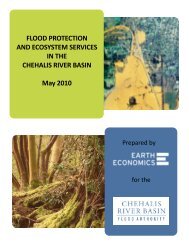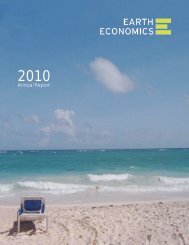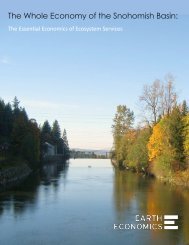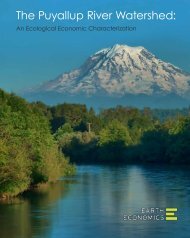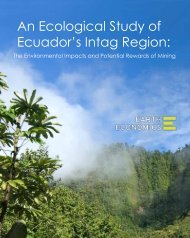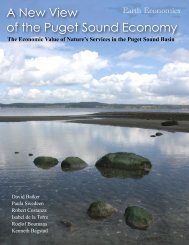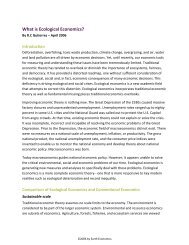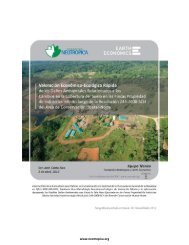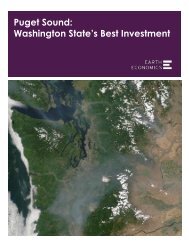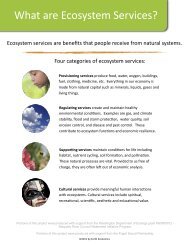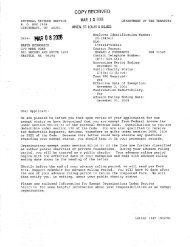The Spot Prawn Fishery: A Status Report - Earth Economics
The Spot Prawn Fishery: A Status Report - Earth Economics
The Spot Prawn Fishery: A Status Report - Earth Economics
You also want an ePaper? Increase the reach of your titles
YUMPU automatically turns print PDFs into web optimized ePapers that Google loves.
<strong>The</strong> <strong>Spot</strong> <strong>Prawn</strong> <strong>Fishery</strong>: A <strong>Status</strong> <strong>Report</strong><br />
•“To ensure conservation and protection of<br />
invertebrate stocks and their habitat through the<br />
application of scientific management principles<br />
applied in a risk averse and precautionary manner<br />
based on the best scientific advice available.<br />
•“To meet the federal Crown’s obligations regarding<br />
Aboriginal fisheries for food, social, and ceremonial<br />
purposes.<br />
•“To develop sustainable fisheries through<br />
partnership and co-management arrangements<br />
with client groups and stakeholders to share in<br />
decision-making, responsibilities and costs and<br />
benefits.<br />
•“To develop fishing plans and co-operative<br />
research programs which will contribute to<br />
improving the knowledge base and understanding<br />
the resource.<br />
•“To consider the goals of stakeholders with<br />
respect to the social, cultural and economic<br />
value of the fishery”<br />
(Fisheries and Oceans Canada 2000a).<br />
This is a fully competitive, limited-entry fishery<br />
that is managed through seasonal closures, inseason<br />
closures, gear limits, mesh size requirements,<br />
and minimum size limits. Two biological<br />
objectives have directed the choice of management<br />
tools: the prevention of growth overfishing<br />
(size limits and trap escapement modifications)<br />
and the prevention of recruitment overfishing (fixed<br />
escapement standard; i.e., spawner index model).<br />
Summary of Commercial Management and<br />
Regulatory Measures<br />
British Columbia’s spot prawn management system<br />
is different from all other spot prawn management<br />
systems. According to Fisheries and Oceans, spot<br />
prawn management in Canada is a “work in progress.”<br />
While management paradigms have historically<br />
focused on short-term yield, there is a need to<br />
change this culture and move toward a more longterm,<br />
precautionary, ecosystem approach. BC is<br />
continually evolving in this direction (Boutillier,<br />
Fisheries and Oceans Canada. Pers. comm., June<br />
2001). Precaution and ecosystem considerations<br />
are central to the BC system. Management operates<br />
on a very fine scale and is highly adaptive.<br />
Fine-scale management is fundamental to achieving<br />
BC’s management goals and central to achieving<br />
long-term sustainability for the spot prawn<br />
fishery. It is obtained through reliance on realtime<br />
management decisions and an involved atsea<br />
monitoring system. This fine-scale management<br />
system is at the crux of reducing the spot<br />
prawn’s vulnerability to serial depletion and<br />
localized overfishing (Boutillier, Fisheries and<br />
Oceans Canada. Pers. comm., October 2001).<br />
This section offers an overview of Canada’s spot<br />
prawn management measures and regulatory<br />
system. For a complete description of British<br />
Columbia’s spot prawn management regime,<br />
see Fisheries and Oceans Canada’s website<br />
(www.pac.dfompo.gc.ca/ops/fm/shellfish/<br />
<strong>Prawn</strong>/prawn).<br />
•In 1979, a biological reference point—the spawner<br />
index—was instituted to manage<br />
fishing effort.<br />
•Harvest log requirements were mandatory as<br />
of 1983. Fishers are required to complete logbooks<br />
describing fishing effort and catch by midnight<br />
of each fishing day. <strong>The</strong> information must<br />
be delivered to Fisheries and Oceans within four<br />
weeks of the month in which fishing occurred.<br />
•Coast-wide seasonal closures were set in place<br />
for the South Coast (Areas 11–29) in 1984 and<br />
along the North Coast (Areas 1–10) in 1989. Prior<br />
to 1984, closures were set to coincide with the<br />
period in which eggs are incubated and larvae<br />
hatched (January–March). Closure timing is<br />
now based on a biological reference point: a<br />
minimum spawner index.<br />
•In 1985, a minimum size limit of 30 mm (1.18<br />
in.) carapace length was instituted. <strong>The</strong> size<br />
limit was increased to 32 mm (1.26 in.) in 1996<br />
and to 33 mm (1.30 in.) in 1997. A minimum<br />
length of telson (middle segment of the tail fan<br />
at the most posterior portion of the tail) of 20<br />
mm (0.79 in.) was established in 1998.<br />
•Trap mesh size limits became obligatory in 1988<br />
to reduce the capture of undersized prawns and<br />
mortality associated with bycatch and sorting.<br />
•A license limitation system, with a length restriction<br />
on transferability, was established in 1990.<br />
•Hailing requirements—i.e., fishers must report in<br />
prior to beginning fishing and on completion of<br />
fishing—were instituted in 1992. Hailing data<br />
facilitates in-season managment of the fishery.<br />
20



